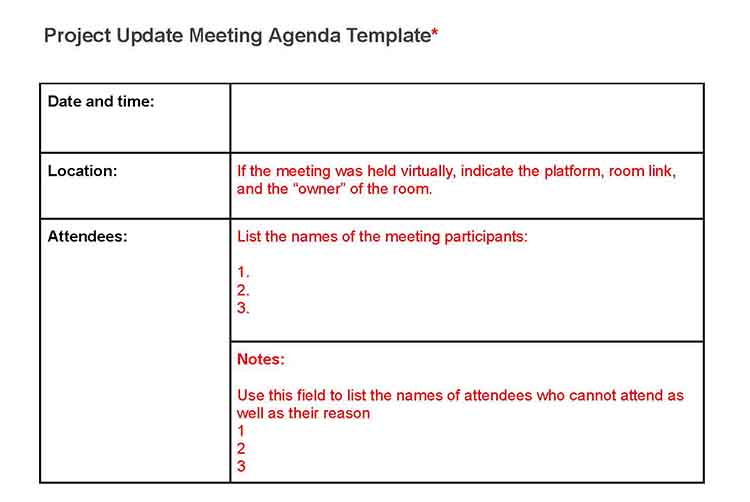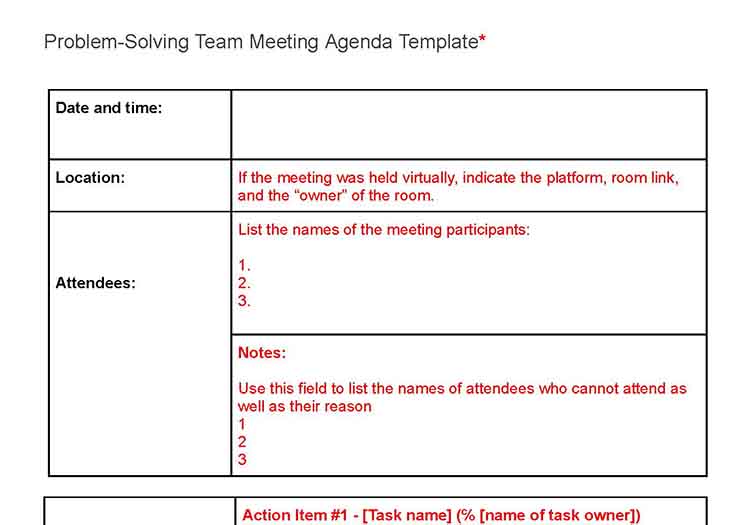Having a meeting agenda provides structure and clarity to meetings, ensuring that time is used effectively and goals are achieved. It helps set clear objectives, outlines discussion topics, allocates time for each item, and identifies responsible parties, ensuring everyone is prepared and on the same page.
To help you get started, here are three team meeting agenda templates you can use—one for regular meetings, one to discuss specific projects, and another for brainstorming solutions to specific problems or issues.
To ensure your meetings achieve their intended goals, follow these steps for running an effective meeting:
- Determine the necessity of the meeting
- Define meeting goals
- Set agenda and send invites
- Start the meeting strong
- Follow the agenda
- Foster collaboration
- Summarize key points
- End the meeting well
For more information on what you need to know, check out our guide on how to run an effective meeting.
Standard Team Meeting Agenda Template
A standard team meeting agenda template outlines the topics, discussions, and action items for a team meeting. This template is commonly used for regular team updates, decision-making meetings, and general team coordination sessions.
Project Update Meeting Agenda Template
A project meeting agenda template is commonly used for project status meetings, where team members provide updates on their progress, address any obstacles, and ensure alignment on the project’s direction. It includes sections for reviewing project milestones achieved, discussing any challenges or issues encountered, and determining next steps.
Developing a meeting agenda template is a vital aspect of effective people management skills that managers should acquire or enhance. It falls within the realm of planning and organizing, which are crucial for efficient employee management. These skills empower managers to effectively plan and organize their own tasks as well as those of their team members.
Problem-solving Team Meeting Agenda Template
A problem-solving team meeting agenda serves as a roadmap to guide the team through the problem-solving process, ensuring a focused and productive discussion. These are typically utilized when a team encounters complex issues or seeks to find solutions.
How to Use Our Meeting Agenda Templates
Our agenda templates are quite easy to use—simply download the form and fill out the necessary details. We’ve already added the most basic components of an agenda template, with the addition of spaces for any extra notes about anything that happens during each portion of the meeting.
Here are some other reminders to keep in mind to fully utilize our team meeting agenda templates:
- Customize the template: Download the meeting agenda template and customize it to fit your specific meeting. Modify the sections (meeting title, date, list of agenda items, etc.) to include the relevant details for your meeting.
- Add agenda items: Identify the topics you want to cover in the meeting and list them as separate agenda items. Start with the most important or time-sensitive items and proceed in a logical order. Make sure to allocate an appropriate amount of time for each agenda item.
- Provide context or background information: For each agenda item, provide a brief description or context to help attendees understand the purpose or objective of the discussion. This will ensure everyone is prepared and knows what to expect in the meeting.
- Assign responsible parties: If certain agenda items require specific individuals to lead or provide updates, assign responsible parties for each item. This ensures accountability and allows attendees to know who is responsible for each topic.
- Set time allocations: Estimate the amount of time needed for each agenda item and allocate time slots accordingly. Be realistic and considerate of everyone’s schedules, ensuring that there’s enough time for discussion and decision-making without running over the scheduled meeting duration.
- Share the agenda with participants: Once you have filled out the meeting agenda template, share it with all the meeting participants in advance. Distribute it via email or a collaboration tool like Google Drive or a project management software. This allows attendees to review the agenda, come prepared, and have a clear understanding of the meeting’s objectives.
- Review and adjust as needed: Before the meeting, review the agenda once again to ensure it is comprehensive and all necessary items are included. Make any adjustments or additions as required based on input from participants or changing priorities.
- Facilitate the meeting using the agenda: During the meeting, use the agenda as a guide to keep the discussion on track and ensure that all agenda items are covered within the allocated time. Encourage participants to refer to the agenda, provide updates, discuss each item, and make decisions accordingly.
- Take notes and follow-up: During the meeting, designate someone to take notes on key discussion points, decisions, and action items. After the meeting, distribute the meeting minutes or summary, including any action items, to all participants. This ensures everyone is informed about what was discussed and aware of their responsibilities moving forward.
Tips for Creating an Effective Team Meeting Agenda Template
A well-structured team meeting agenda is the foundation for productive and focused discussions. It sets the tone, provides clarity, and ensures that valuable time is utilized efficiently. To help you create an effective team meeting agenda template, we compiled a set of valuable tips.
- Understand the Purpose: Clarify the purpose and goals of the meeting. This will help you determine the necessary agenda items and focus on what needs to be accomplished.
- Be Clear and Specific: Use clear and concise language when describing agenda items. Make sure the agenda item titles accurately reflect the content to provide clarity for participants.
- Include Preparation Requirements: If there are any materials, reports, or tasks that team members need to prepare before the meeting, mention them in the agenda. This ensures everyone is well-prepared and can contribute effectively.
- Leave Room for Flexibility: While it’s important to have a structured agenda, allow some flexibility for unexpected discussions or time-sensitive issues that may arise during the meeting. Consider adding an “Additional Items” section at the end of the agenda for such situations.
- Consider the Meeting Flow: Structure the agenda items in a logical order that facilitates smooth transitions and meaningful discussions. Place important or critical items earlier in the agenda when participants are likely to be most attentive and engaged.
- Use Technology Tools: Consider using collaborative tools or software that allow team members to contribute to the agenda or provide input. This promotes transparency and engagement within the team.
Remember, the goal of a meeting agenda template is to provide structure, clarity, and direction for productive discussions. Create a template to suit the specific needs of your team and be open to making improvements based on feedback and experience.
Bottom Line
Meeting agenda templates are valuable tools that promote organization, efficiency, and productivity in team meetings. They provide a consistent structure and outline for discussions, ensuring that important topics are addressed and time is utilized effectively. By using them, teams can streamline their meetings, enhance communication, and achieve better outcomes.


